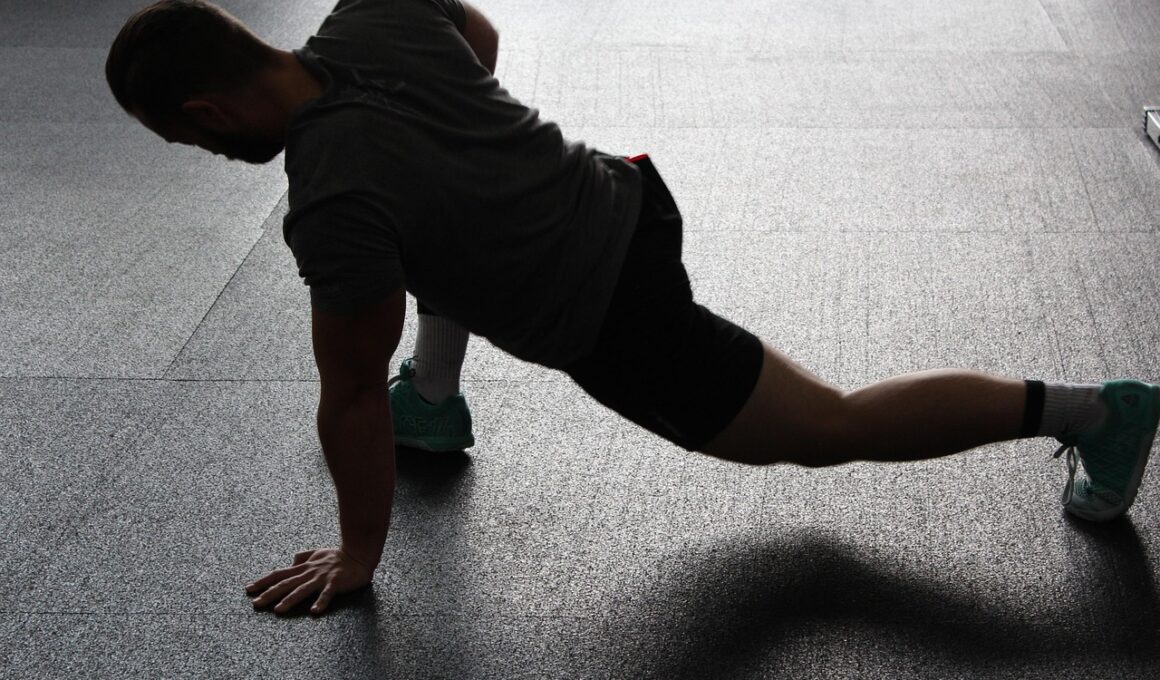The Future of Sport-Specific Dynamic Warm-Ups: Trends and Research
Sport-specific dynamic warm-ups are integral in preparing athletes for their respective disciplines. These warm-ups enhance performance, reduce the likelihood of injuries, and increase overall readiness. By targeting specific muscle groups and motions, athletes achieve improved flexibility, mobility, and physical awareness, all crucial for optimal performance. Research consistently highlights the importance of dynamic warm-ups over static routines, leading to enhanced power output and agility. Dynamic warm-ups typically include various movements tailored to the sport, incorporating strength, coordination, and cardiovascular elements. Implementing individualized routines has proven beneficial, tailoring exercises to cater to the athlete’s unique needs. The use of technology allows for personalized warm-up sessions, with feedback from performance analytics guiding modifications. Athletes can leverage wearable devices to track physiological responses during warm-ups, adapting their routines for maximum effectiveness. Furthermore, various training methodologies emphasize the importance of group dynamics during warm-ups encouraging team cohesion, communication, and motivation. In the evolving landscape of athletic training, dynamic warm-ups represent a critical area of research, continually adapting to the latest findings and methodologies in sports science. This ensures athletes remain in peak condition while minimizing injury risks.
Innovative Approaches to Warm-Ups
As we look toward the future, innovative approaches to dynamic warm-ups for athletes are gaining traction. Coaches and trainers increasingly explore incorporating neuromuscular activation techniques to enhance engagement during warm-ups. These techniques focus on stimulating the nervous system through specific movements, thereby improving coordination and readiness. Integrating elements of balance, speed, and agility drills provides athletes with comprehensive preparation. Additionally, using feedback loops from technology enables customization based on observed performance indicators. Utilizing sport-specific movements that replicate game scenarios during warm-ups enhances responsiveness and overall engagement. Furthermore, mental preparation is becoming recognized as integral to physical readiness. Visualization techniques and cognitive strategies help athletes become mentally attuned to their upcoming performance, calming nerves and increasing focus. The role of flexibility exercises is adapting, moving towards more dynamic alternatives rather than traditional static stretches. These dynamic options actively engage muscles in functional patterns. Fitness professionals are also recognizing the value of incorporating recovery elements within warm-ups to stimulate blood flow and reduce soreness. As these innovative practices evolve, we can expect a significant shift in traditional paradigms surrounding athlete warm-up routines.
A key focus in the ongoing development of dynamic warm-ups for athletes is the application of scientific research. Recent studies indicate the benefits associated with sport-specific warm-ups can significantly enhance performance metrics, showcasing improvements in speed, strength, and endurance. Traditionally, training regimes have relied heavily on generalized warm-up routines, often overlooking the specialized demands of individual sports. With ongoing research, there’s a growing trend to tailor warm-ups to prioritize sport-specific movements, ensuring that athletes engage in activities that closely resemble their actual performance. For example, soccer players may focus on lateral movements and kicking exercises, while runners emphasize leg swings and mobility drills. Such specialization not only improves athletic performance but also reduces injury risk by preparing the body for sport-specific stresses. Coaches are encouraged to regularly review research findings to integrate the latest insights into their training programs. The importance of periodization is also highlighted, as structured warm-up routines can align with overall training cycles, improving adaptation and performance. Through an evidence-based approach, evolving practices and continual assessment will reshape how athletes prepare for their respective sports.
Technology’s Role in Dynamic Warm-Ups
Technology is revolutionizing how athletes engage in dynamic warm-ups, pushing the boundaries of performance preparation. Numerous mobile applications and wearable devices provide real-time feedback about physical performance. This data allows coaches and athletes to assess the effectiveness of specific warm-up routines. Biometric tracking tools monitor heart rates, oxygen levels, and muscle activation, guiding adjustments during warm-ups and ultimately improving safety. Incorporating video analysis ensures athletes maintain proper form during dynamic movements, decreasing the likelihood of injury. Moreover, gamification of training is emerging as an effective strategy, where warm-ups are transformed into interactive experiences. Athletes become invested in their preparation routines, enhancing motivation and enjoyment. Virtual reality also holds potential for simulating sport environments, allowing athletes to mentally acclimate to the pressures of competition during warm-up phases. As we continue to embrace advancements in sports technology, traditional warm-up methods may evolve significantly. Coaches must stay informed about new technological tools to enhance warm-up protocols. Emphasizing efficiency, safety, and effectiveness will be paramount as technology integrates more deeply into athlete training.
As new trends in sport-specific dynamic warm-ups continue to develop, the significance of coaching education cannot be overstated. Coaches form the nexus for implementing innovative warm-up protocols designed to boost performance. Consequently, coaches must invest in education that aligns with cutting-edge research to enhance their effectiveness. Professional workshops, conferences, and training opportunities enable coaches to remain abreast of developments in dynamic warm-up practices. Additionally, networking within the coaching community fosters shared knowledge and collaborative methodologies that can enhance athlete performance. Enhancing coaching skills in providing athlete-centered warm-up sessions will maximize physical preparation. Coaches should also prioritize the development of athletes’ self-awareness regarding importance during warm-ups. When athletes understand the purpose behind their warm-ups, they become more engaged in the process. Combining teaching methods with new research ensures athletes are fully prepared for their sports. Incorporating qualitative feedback from athletes after each training session enriches coaching methodologies by continuously refining tactics. This coaching evolution catalyzes a broader acceptance of vital warm-up practices, embedding them into the fabric of sports training. As we adapt and refine our approaches, performance will improve through informed, strategic, athlete-centered movements.
Future Trends to Consider
Looking ahead, various future trends will likely shape dynamic warm-ups for athletes further. One emerging trend is a greater emphasis on recovery methods intertwined with warm-up routines, prioritizing holistic athlete well-being. Integrating techniques such as foam rolling and mobility exercises into warm-ups can enhance muscle recovery and flexibility, ultimately leading to improved performance and reduced injury risks. Another prospective trend is the expanded use of artificial intelligence in analyzing athlete performance, offering customized solutions to optimize warm-up efficacy. AI could assess movement patterns, identify weaknesses, and recommend specific warm-up activities tailored to the individual athlete’s needs. Additionally, as public interest in health and fitness increases, athletes at all levels may start adopting dynamic warm-ups regardless of their competitive status, thus influencing grassroots sports involvement. Emphasizing the importance of mental health, warm-ups could incorporate mindfulness elements to focus athletes’ mental states. Lastly, cross-disciplinary collaboration among physiologists, trainers, and sports scientists will facilitate sharing knowledge, resulting in holistic warm-up strategies. By embracing these trends, the sports community can work together to redefine preparation protocols, fostering both performance and athlete longevity.
In summary, the future of sport-specific dynamic warm-ups is poised for innovative transformations motivated by research, technology, and evolving coaching practices. The movement towards individualized and science-backed warm-up strategies is essential in ensuring athletes reach their full potential. As knowledge in sports science expands, integrating effective methodologies that prioritize physical and mental readiness should remain the norm. Collaboration between coaches, athletes, and researchers is crucial for maintaining an adaptive approach that ensures adaptability to individual and sport-specific needs. Empowering the coach’s role through ongoing education and resource sharing is key to evolving warm-up practices. By incorporating modern technology, coaches can optimize warm-ups tailored to the unique demands of each athlete. Furthermore, we observe a shift in how warm-ups are structured, moving towards enhancing recovery and focus on mental health. Through intentional training implementations, athletes will see improvements in performance metrics unprecedented in history. The realm of dynamic warm-ups holds great potential for innovation, drastically shaping the landscape of training worldwide. As the athletic community embraces these changes, the effectiveness and safety of sports practices will soar, paving the way for the future of athletic excellence.
Engaging in comprehensive dynamic warm-ups allows athletes not only to prepare mentally and physically but also to establish a routine that emphasizes the importance of warm-up protocols. With an increasing array of resources available, integrating contemporary research findings into daily training regimens will ultimately elevate athlete preparedness, coaching practices, and athletic performance. Coaches must prioritize the ongoing development of dynamic warm-ups to create pathways for success in a highly competitive athletic arena. Athletes, too, should take ownership of their preparation, engaging actively in the processes that lead to their best performance. In a nutshell, embracing the future of sport-specific dynamic warm-ups nurtures a culture of excellence, ensuring athletes can perform at their most optimal level while enjoying the overall journey in their respective sports.


